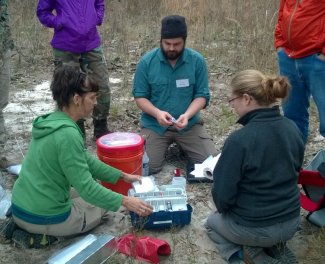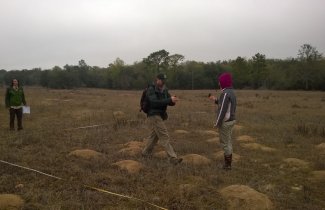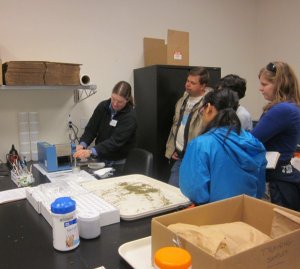Spring Training in Florida
May 21, 2014
By Liz Knapp
I recently returned from a week of training in Florida. No, not for baseball, but for Big Data. More specifically, how to collect samples for NEON’s Terrestrial Observation System. You know…insects, plants, soils, microbes, mammals, and pathogens. With a push of a button, you’ll be able to access data about all of these things: their distribution, abundance, diversity, phenology, biomass, chemistry, etc. But before NEON puts these data at your fingertips, they have to literally pass through our technicians’ fingertips. What am I talking about?
Thousands of insects, hundreds of soil cores and small mammals, myriad plant measurements and specimens. As I write this post, our field technicians are probably out collecting these data right now. They are up before the sun rises to check mammal traps, or determining percent cover of plant species on a 90° day with 100 percent humidity, or—just the opposite—trekking through two feet of snow to measure tree diameters as this winter drags on. When you pull up nutrient data for soil cores from across the United States, remember this: They were collected by our hardy and conscientious field technicians.
Our Mantra
At the heart of NEON data is the use of consistent methods across a variety of ecological systems. If you asked anyone who attended the Florida training for a take-home point, it will probably be “follow the protocol.” Excuse me, that should be “follow the protocols,” all twenty of them. And that is just for the terrestrial organismal sampling program. We went through and practiced the twelve first-year sampling protocols over five days of training.
Our Challenge
The challenge for NEON is ensuring that every field technician is implementing each sampling method in the same way…for 30 years. This field season, we’ll have over 80 seasonal technicians spread across the United States (cue up: “From the redwood forests, to the Gulf Stream waa,aaaters…”). When NEON is in full operation in 2017, we’ll have approximately 500 seasonal technicians. Guess what? They will all need training at the beginning of each field season. To complicate the task even more, the start of the field season varies by location. In some domains, sampling (and the arrival of seasonal technicians) begins in March, while in others, not until April, May, or even June. We needed a training program that can grow as the observatory expands and accommodate different start dates.

Small mammal sampling at Florida field site in Domain 03.
Our Plan
How do we go about training everyone? That was the question posed to me when I joined NEON over a year ago as NEON’s Senior Curriculum Designer, just in time for the 2013 field season. Shadowing our crews as they sampled the dense forests of Massachusetts and the wind-swept plains of Colorado, the answer occurred to me. Our field technicians—who are with NEON all year, not just during the field season—have an incredible wealth of ecological knowledge, a deep understanding of the nitty-gritty details of the protocols, as well as the science and rationale behind the methods, and many of them have teaching experience. Everything we need in a trainer! Now all we needed was a training curriculum and a way to deliver it.
From Protocol to Lesson Plan
I spent last winter writing and refining a training curriculum. Working with the protocol authors and technicians, we put together presentations, instructional videos, handouts, worksheets, recorded lectures, assessments, and tips for teaching. For those of you familiar with education lingo…a lesson plan. The goal was a curriculum that covered technical information, but also provided hands-on practice and opportunities to apply information. That meant including exercises and activities that required trouble-shooting, problem solving, and discussions about the how and why of a protocol.
Any Volunteers?
Once the curriculum was developed, we put out the query to our full-time technicians in Colorado, Florida, and Massachusetts, the three domains with one or more NEON field seasons under their belts. “Anyone interested in training your colleagues? We’ll provide the curriculum, we’ll coach you on effective teaching methods, we’ll set up time for you to meet with the protocol authors and thrash through details, we’ll give you time to practice your presentation and hone your teaching skills. When will you do all this? Two weeks before you need to turn around and train your colleagues.”
As I’ve mentioned already, we have a highly skilled and competent crew, so they volunteered! Twelve of the full-time technicians gathered at NEON’s Colorado headquarters in early February for a four-day train-the-trainer workshop. They practiced using the curricular materials, presented and critiqued presentations with one another and NEON staff scientists, worked with the protocol authors, made curriculum edits based on last-minute protocol changes, and refined lesson plans.

Soil Sampling in the Southeast Domain
Armed with the curriculum, our newly-minted trainers provided classroom, field, and lab training to their colleagues from twelve NEON domains. Participants learned the intricacies of the protocols, practiced in the field and lab, and asked many questions. They left with heads full of details, suitcases exploding with curricular materials, and a new network of professional relationships with colleagues throughout NEON. In other words, everything they needed to start their field season and train seasonal field technicians at their domains.
Key to Our Success
Our trainers are knowledgeable. They shared tips and tricks that fleshed out some of the details of how to actually implement a procedure. For example, removing soil from a slide-hammer corer, keeping track of tiny locality labels, or placing mammal traps. Some of these workflow tips are so helpful they will be added to the protocols.
Trainers, take a victory lap! Monique Kerstein, May Lehmensiek, Jen Eells, Ben Vierra, Dave Crandall, Kirstin Godfrey, Carol Goranson, Nick Schroeter, Kevin Barrett, Bernice Hwang, Dave Durden, and Sean Hauser, thank you for your time, support, and dedication to training. It’s going to be a great field season.
Special thanks also to Tami Bowman for logistical support and to the NEON protocol authors who helped with curriculum and worked with our trainers: Dave Barnett, Eve Hinckley, David Hoekman, Katie Jones, Courtney Meier, Jacob Parnell, Yuri Springer, and Kate Thibault.
